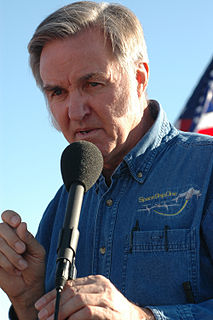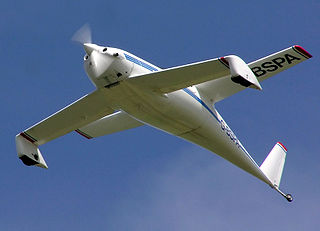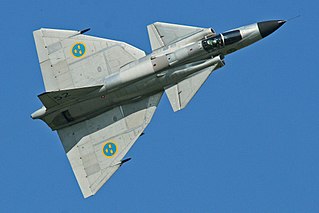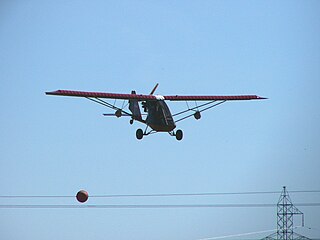
Elbert Leander "Burt" Rutan is a retired American aerospace engineer and entrepreneur noted for his originality in designing light, strong, unusual-looking, and energy-efficient air and space craft. He designed the record-breaking Voyager, which in 1986 was the first plane to fly around the world without stopping or refueling, and the Virgin Atlantic GlobalFlyer, which in 2006 set the world record for the fastest and longest nonstop non-refueled circumnavigation flight in history. In 2004, Rutan's sub-orbital spaceplane design SpaceShipOne became the first privately funded spacecraft to enter the realm of space, winning the Ansari X-Prize that year for achieving the feat twice within a two-week period.

The De Havilland Canada DHC-8, commonly known as the Dash 8, is a series of turboprop-powered regional airliners, introduced by de Havilland Canada (DHC) in 1984. DHC was later bought by Boeing in 1988, then by Bombardier in 1992; then by Longview Aviation Capital in 2019, reviving the De Havilland Canada brand. Powered by two Pratt & Whitney Canada PW100s, it was developed from the Dash 7 with improved cruise performance and lower operational costs, but without STOL performance. Three sizes were offered: initially the 37–40 seat -100 until 2005 and the more powerful -200 from 1995, the stretched 50–56 seats -300 from 1989, both until 2009, and the 68–90 seats -400 from 1999, still in production. The QSeries are post-1997 variants fitted with active noise control systems.

The Rutan Model 61 Long-EZ is a tandem 2-seater homebuilt aircraft designed by Burt Rutan's Rutan Aircraft Factory. The Long-EZ has a canard layout, a swept wing with wingtip rudders, and a pusher engine and propeller. The tricycle landing gear has fixed main wheels with streamlined spats and a retractable nosewheel. Its predecessor was the VariEze, plans for which were first available to homebuilders in 1976. The prototype Long-EZ, N79RA, first flew on June 12, 1979.

The Rutan VariEze is a composite, canard aircraft designed by Burt Rutan. It is a high-performance homebuilt aircraft, hundreds of which have been constructed. The design later evolved into the Long-EZ and other, larger cabin canard aircraft. The VariEze is notable for popularizing the canard configuration and moldless glass cloth composite construction for homebuilt aircraft.

Homebuilt aircraft, also known as amateur-built aircraft or kit planes, are constructed by persons for whom this is not a professional activity. These aircraft may be constructed from "scratch", from plans, or from assembly kits.

The Rutan Quickie is a lightweight single-seat taildragger aircraft of composite construction, configured with tandem wings.
The Bede BD-1 was a two-seat, single-engine, low-wing monoplane, the first design of American aeronautical engineer Jim Bede. The BD-1 was designed in 1960 as a kit-built aircraft intended for home assembly by amateur builders. Design goals included a kit price of $US 2500, including a rebuilt 100 hp (75 kW) engine and a cruise speed of 130 knots (240 km/h). The prototype N624BD first flew in 1962.

A tandem wing arrangement has two main wings, with one located forward and the other to the rear. Both wings contribute to lift. Tandem wings are rare, but they do appear in both nature and aviation.

The Berkut 360 is a tandem-seating, two-seat homebuilt canard aircraft with pusher configuration and retractable landing gear, built primarily of carbon fiber and fiberglass.

In aeronautics, a canard is an arrangement wherein a small forewing or foreplane is placed forward of the main wing of a fixed-wing aircraft or a weapon. The term "canard" may be used to describe the aircraft itself, the wing configuration, or the foreplane. Canard wings are also extensively used in guided missiles and smart bombs.

The Viking Dragonfly is an American amateur-built aircraft, designed by Bob Walters and produced by Viking Aircraft LLC of Elkhorn, Wisconsin. The aircraft is supplied as a kit or as plans for amateur construction.

The Pterodactyl Ascender is a family of U.S. designed and built ultralight aircraft that were sold in kit form between 1979 and 1984 under Pterodactyl Limited and is currently being sold by DFE Ultralights.

The Birdman Chinook is a family of single and two-place, pusher configuration, high-wing ultralight aircraft that was first flown on 12 December 1982 and produced by Birdman Enterprises of Edmonton, Alberta, Canada starting in 1983.
The Quickie Aircraft Corporation Free Enterprise was an American experimental long-range aircraft of the 1980s, designed to attempt the first unrefuelled flight round-the world flight. The Free Enterprise was a single-engined high-winged monoplane of conventional configuration. It first flew in March 1982, but was destroyed in a fatal crash later that year.

The Falconar Golden Hawk is a Canadian tandem seat, pusher configuration, tricycle gear, canard-equipped ultralight aircraft that is offered in kit form by Falconar Avia of Edmonton, Alberta.

The Rutan Model 77 Solitaire is an American, single seat, canard, mid-wing motor glider that was developed by Burt Rutan in response to the 1982 Sailplane Homebuilders Association Design Contest for a homebuilt glider. The Solitaire was declared the winner of the contest and its unusual layout attracted a great deal of attention. For a time in the 1980s the aircraft was available as plans and as a kit.
The American Aerolights Eagle is an American ultralight aircraft that was produced by American Aerolights, introduced in 1975. The aircraft was supplied as a kit for amateur construction.
The AeroCad AeroCanard is a family of American amateur-built aircraft, designed and produced by AeroCad of Florissant, Missouri. The aircraft is supplied as a kit for amateur construction.

The Quickie Q2 or Q2 is a two-seat version of the unique Rutan Quickie, produced in kit form by the Quickie Aircraft Corporation founded by Tom Jewett and Gene Sheehan. Canadian Garry LeGare was involved in the design.


















